Building wealth is a multifaceted journey that involves making informed financial decisions. Two fundamental strategies in this pursuit are saving money and investing. While both play crucial roles in securing financial stability, understanding the distinctions and benefits of each can empower individuals to make sound choices tailored to their financial goals.
Saving Money:
Saving money is a foundational financial practice that involves setting aside a portion of one’s income for future needs or emergencies. This conservative approach offers immediate liquidity and security, providing a financial cushion for unexpected expenses or unforeseen circumstances. Here are key aspects of saving money:
- Liquidity and Accessibility:
- Savings are easily accessible in times of need, making it a reliable source of emergency funds.
- Traditional savings accounts or high-yield savings accounts provide a safe and secure environment for storing money.
- Risk-Aversion:
- Savings are generally considered low-risk, as the principal amount is protected, and there is no exposure to market fluctuations.
- Short-Term Goals:
- Ideal for short-term financial goals like creating an emergency fund, saving for a vacation, or making a significant purchase in the near future.
Investing:
Investing, on the other hand, involves putting money into various financial instruments with the expectation of generating returns over time. Unlike saving, investing carries inherent risks, but it also offers the potential for higher returns. Here are key aspects of investing:
- Wealth Growth:
- Investing has the potential to grow wealth over the long term, providing a hedge against inflation and helping money work for you.
- Diversification:
- By investing in a diversified portfolio of assets such as stocks, bonds, and real estate, individuals can spread risk and enhance the potential for returns.
- Long-Term Goals:
- Well-suited for long-term financial goals like retirement planning, building a college fund, or creating generational wealth.
Balancing Act:
The key to financial success lies in finding the right balance between saving and investing. While saving ensures financial security and liquidity, investing facilitates wealth creation and growth. Striking the appropriate balance depends on individual financial goals, risk tolerance, and time horizon.
- Emergency Fund:
- Prioritize building an emergency fund through saving to cover three to six months’ worth of living expenses.
- Invest for Long-Term Goals:
- Allocate a portion of savings to long-term investments, considering a diversified portfolio to manage risk.
- Regular Review:
- Periodically reassess financial goals, risk tolerance, and investment strategies to ensure alignment with evolving life circumstances.
Conclusion:
Saving money and investing are not mutually exclusive; rather, they are complementary components of a comprehensive wealth-building strategy. The key is to strike a balance that aligns with individual financial goals, risk tolerance, and time horizon. By understanding the nuances of saving and investing, individuals can navigate the financial landscape with confidence, securing their present and building a prosperous future.


